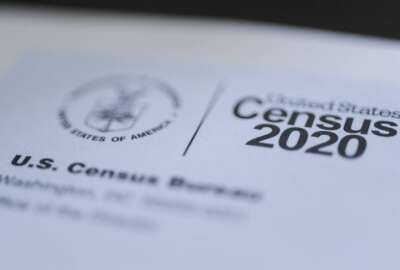Hubbard Radio Washington DC, LLC. All rights reserved. This website is not intended for users located within the European Economic Area.
Air Force tells program managers: Don’t expect reprieve from sequestration
Any relief the Air Force gets from a pending budget deal will be pushed into rebuilding lost military readiness, not bolstering investment programs, a top acqui...
wfedstaff | April 17, 2015 5:57 pm
The federal spending accord House and Senate negotiators announced this week would ease up on sequestration cuts to the Defense Department during 2014.
But agreement or no, the Air Force is telling its program managers they shouldn’t expect to see one nickel’s worth of relief to their acquisition programs.
Amid ongoing budget uncertainty, the service has instructed its acquisition offices that they should plan to execute their programs at the same level they were funded during fiscal 2013’s sequestered budget.
Officials don’t yet know the impact of the budget deal on DoD with precision, said Lt. Gen. Charles Davis, the military deputy to the Air Force’s assistant secretary for acquisition.
For now, they’re only expecting it to reduce the Air Force’s sequestration bill by a few billion dollars. And any relief that comes will be directed to restoring some of the military readiness that was degraded during the first year of the cuts as the military was forced to halt training exercises and reduce flying hours.
“As we have to make further trades across whatever numbers we’re given, it really is going to come from our investment program,” Davis said Thursday at the annual Air Force IT day hosted by AFCEA’s Northern Virginia chapter. “And even within those investment programs, a large chunk of that money is already decided and already blocked off from being able to use for other activities. And believe it or not, there’s a lot of folks out there who think they know how the Air Force should spend its budget a lot better than the Air Force does. That creates a unique challenge.”
Davis said the limited decision space within the overall budget means that acquisition in the Air Force is now a zero sum game.
“Nobody brings a new idea or a new program to the table without it coming from an existing program,” he said. “Nobody gets to go to Congress and say, ‘I really wish you’d tell the Air Force they have to keep this’ without something else being taken off the table. That just can’t happen anymore. Everything we bring back in or add, something has to go. That’s how we’re building our budgets right now. For that reason, any redundant or excess capabilities are something we just can’t afford by any stretch of the imagination.”
At the same time, the Air Force says it can’t afford to take a holiday on new procurement right now. After more than a decade of high tempo operations, the service says it desperately needs to recapitalize an aging fleet and tackle other high-priority areas like science and technology.
Davis said that means the Air Force’s only choice is to reduce the cost drivers in its procurement programs.
“So we’ve asked all our program managers to tell us what that flat line means and how they’re going to execute that. That means we have to curb our requirements, we have to manage what we want for technology, we have to be very judicious about the capabilities we ask for,” he said. “And we need to make sure industry tells us what the costs of these requirements truly are going to be based on how they work that program. And if we can make some change to that requirement because there’s a very steep knee in the curve somewhere, we need to hear that from you. You need to tell us ‘no’ more often, and we need to listen. That’s something we’re not very good at.”
Davis said there are a “vast number” of ways in which the Air Force can get lower prices for products and services without cutting into industry profits or reducing the amount of capability it ultimately gets.
For starters, he said the Air Force needs to pay more attention to designing procurements that reduce the cost of the solicitation process on both the government and industry side.
“One thing we’re seeing, whether it’s a product program or a services program, the proposal process to get us to the point where we actually obligate money is too long, it’s too expensive, it’s too cumbersome, it’s too painful,” he said. “The Air Force traditionally loses somewhere around $600 million a year from our budgets every year, because the money expires before we can obligate it. That’s for a lot of reasons. The program maybe slips or gets canceled or has a schedule that stretches out. But a lot of that money gets lost because we take way too long to get it on contract. That hurts the industry, that hurts the military, and it’s something we just have to pay attention to.”
Likewise, Davis says the Air Force needs a sharper focus on one of the tenets of DoD’s Better Buying Power initiative — reducing processes that don’t add value, but do add cost, particularly in the area of acquisition oversight.
“The oversight process, whether it’s in the Air Force or in the (Office of the Secretary of Defense) is just way too burdensome to actually have much velocity in programs,” he said. “Oversight is still very much en vogue as a way to improve programs, but in my view it’s actually counter to that. The increasing amount of oversight has actually detracted from program performance immensely, although I promise you that’s not a unanimously held view in our department. The root cause of challenges that we’ve had in our programs have started the day we put them on contract, because of some structure within the contract or some requirement that was going to be a challenge or technology that was going to be too hard to deliver or something. Even the best execution in the world was not going to overcome the flaws that were built into the program the day the contract was signed.”
Davis said the Air Force is going to get much more specific in its contracts and make a serious push to ask for more mature, more affordable technologies.
But he said defense contractors have some work to do as well in order to help the Air Force reduce procurement costs. He says too many vendors don’t have a solid understanding of the cost structures of the lower-tier subcontractors they rely on, and as a result, submit proposals that aren’t realistic.
Also, as the defense industry restructures to make itself leaner and more efficient, the Air Force would like to benefit from those efficiencies, Davis said.
“There’s a story every day about how some company has consolidated, downsized, reduced its overhead, staff, and it’s going to reduce cost immensely. I gotta tell you, that is not showing up in the contracts yet,” he said. “The things we are seeing right now, every time a new rate structure is submitted across one of our programs, those costs go up, not down. When these costs account for about 30 to 60 percent of a program, if we can’t drive those out, we’re never going to be able to get your costs down so we can increase your profit.”
RELATED STORIES:
Budget deal offers stability to Pentagon spending
DoD braces for a future of degraded military readiness
DoD waging ‘continuing war’ on unproductive acquisition bureaucracy
Copyright © 2024 Federal News Network. All rights reserved. This website is not intended for users located within the European Economic Area.
Jared Serbu
Jared Serbu is deputy editor of Federal News Network and reports on the Defense Department’s contracting, legislative, workforce and IT issues.
Follow @jserbuWFED





